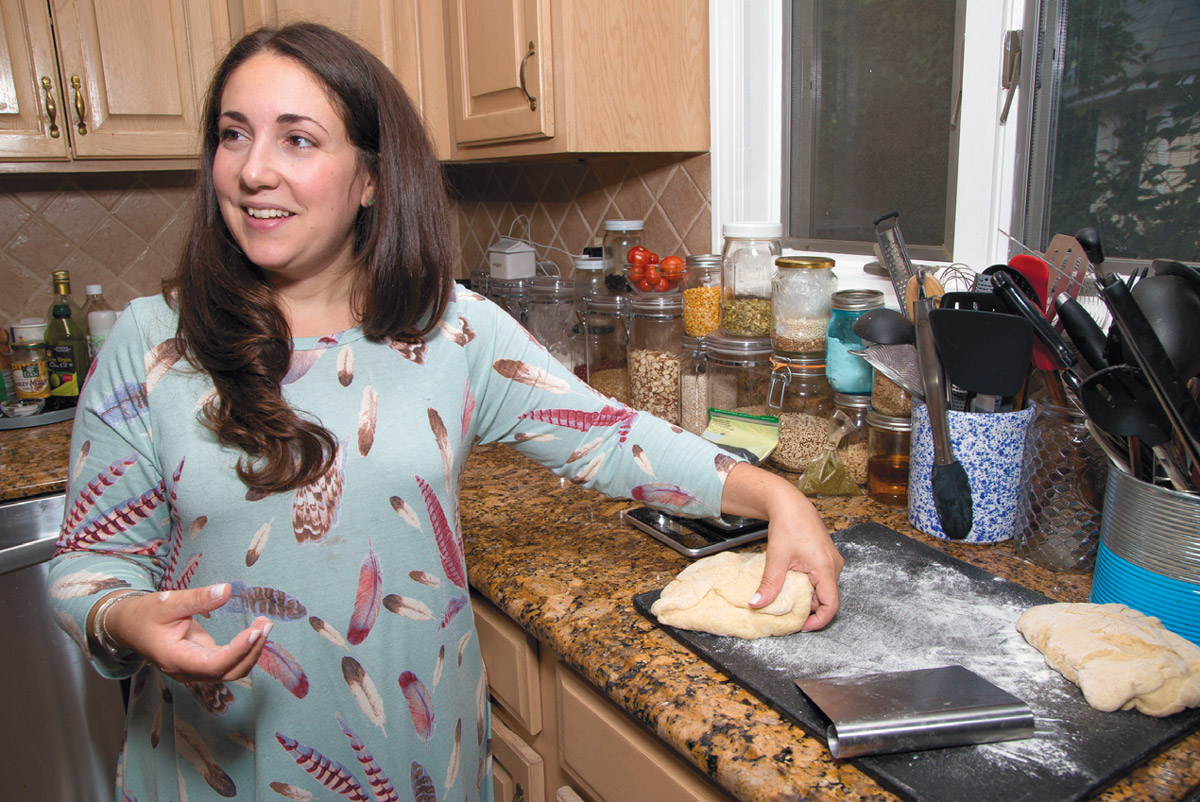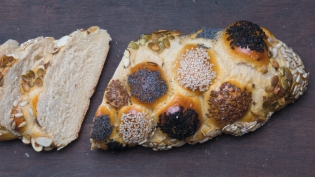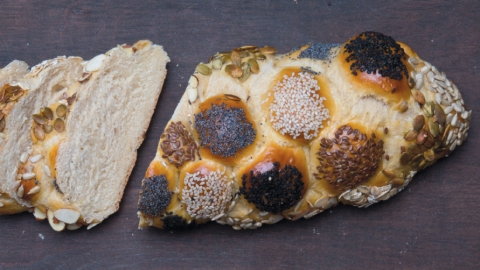In the Kitchen: Shannon Sarna
Modern Jewish baking with Shannon Sarna
Jewish baked goods have brought families together around the table for centuries. In food writer and editor Shannon Sarna’s childhood home, that tradition came with Italian accents. Yiddish quips and rugelach mixed with her mother’s Christmas cookies. The December holidays overlapped.
Dad, a musician, was an early Food Network adopter, cooking dinners for his kids on weeknights. Mom was in musical theater, whipping up meatballs on weekends. Mom also was an avid home baker, working steadily through a beloved 1975 edition of Beard on Bread. Sarna’s favorite was the banana bread. And as her mother creamed butter and sifted flour, Sarna had official duties: to chop the walnuts. The book still sits in Sarna’s South Orange home, its pages bearing the marks of avid use: coffee-cup rings and batter splatters, scattered dots of oil.
Only now, Sarna is the one guiding the bakes, her five-year-old daughter Ella sometimes serving as kitchen co-pilot. (By Ella’s estimation, challah should always be decorated with M&Ms or sprinkles.)
When her mother died, Sarna was a teenager. As caretaker for her two siblings, she took it upon herself to learn the classic bakes of Judaism. In part, it was a way to explore her Jewish identity. More centrally, it allowed her to nurture her younger brother and sister. And for reasons that Sarna can’t quite explain, challah was the first recipe that she decided to master.
It was an impulse that would shape her career.
Today, Sarna braids her dough with an easy rhythm that reveals how deeply this part of her identity is ingrained. As writer, recipe developer and editor of the Jewish-themed website, The Nosher, Sarna has become a powerful voice in the Jewish food world. Exploring the cuisine of the diaspora, she celebrates its diversity of expression—particularly in America, where mixed-heritage Jewish families have redefined the nature of the cuisine.
“All of Jewish cuisine is mixed-heritage stories,” she says.
In Modern Jewish Baker, her first cookbook, which was published in September, Sarna applies that ethos to the world of Jewish bakes. In so doing, she pays homage to tradition while reinvigorating it with updated flavors and new ideas. “The concept of a braided bread on the Sabbath is one that is truly Jewish and sacred,” she writes in the introduction to the challah chapter. “The secret about challah that I want to share with you is that, while for some people it is an intimidating baking task, it is one of the most forgiving breads you can make.”
Sarna’s book takes readers on a page-by-page tour through seven classic Jewish doughs—challah, babka, bagels, hamantaschen, rugelach, pita and matzah. Then she presents a bake-your-own adventure, offering plenty of Instagram-worthy twists. (S’mores babka and everything-bagel rugelach, anyone?) Novices and experienced bakers alike are guided in braiding beautiful loaves that are both forward-thinking and ancient.
INFLUENCES AND TRADITIONS
Do mixed culinary stories have a special place in Jewish cuisine?
As editor of a website with lots of diverse Jews, everybody has an opinion. We can go through a Jewish cookbook and see how what we think of Jewish food was actually European. People will say, that’s not really Jewish food. It’s not really Israeli food. It’s Syrian. It’s Iraqi. And that is also true—but Jews lived in Iraq and Syria and Lebanon and Iran, and still live in Iran. Jews have adopted and adapted the foods of all of the places they lived. Challah was adapted in Europe. Bialy came from Poland. Borscht is Russian. Brisket: There’s no such thing as brisket in Israel. It was an American adaptation.
Everything about Jewish food is actually mashed up.
What I feel is happening in America is you see bloggers and chefs who are taking their heritage, experience and travels and creating fusion dishes. We’re having a moment where Jewish food is exciting to Jews and non-Jews, and why shouldn’t it be? The American Jewish community is far more hodge-podge than many other places. That’s why those people and their recipes and their stories excite me: This is demonstrative of who we are as a people today.
Is Jewish baking in a period of similar transformation?
There are a lot of home bakers doing interesting things. There has always been a culture of women selling challah out of their homes, and I see on Instagram a lot of women who are making innovative challah.
What are some of your early food memories?
I grew up baking all of these American classics with my mom: bread pudding, banana bread, brownies, chocolate chip cookies. She had this old-school nut chopper, so it was always my job to chop the nuts. I learned to make meatballs with her, and eggplant—she would lay out paper bags on the counter and slice the eggplant and salt it.
My grandfather, Edward Sarna, was a food chemist. So, my father and my uncle loved to cook. My father became obsessed with The Food Network very early, and loved experimenting in the kitchen. My parents had alternating schedules, so my dad spent a lot of time at night with us. My mom would be home in the afternoon and then she would go out teaching or performing at night, [so] my dad was often the one making dinner with us. Then my dad would play on the weekends, and my mom would be home with us Friday and Saturday nights.
I didn’t really start to cook and bake until my mom passed away. I was 16.
Did that shape your understanding of food as an act of nurturing?
Absolutely. Not even a question. When my brother comes over, the first thing I say to him is: “What do you want to eat? What can I feed you?” He’ll give me the list of things that he wants every time he comes in. It’s the comfort foods. He loves grilled cheese sandwiches, because that’s what I would make for them for lunch on Saturdays.
How do the Jewish and Italian components of your culinary identity intersect?
There’s this debate about matzah balls: sinkers or floaters. Some people like them very light; some people like them very dense. I like them lighter, and use the technique that I learned rolling meatballs with my mom. I add all kinds of Mediterranean flavors to my challahs.
My husband, Jonathan, has also been a big influence. He gave me so much confidence, and he loves cooking. He really encouraged me to try things. He’s a very good cook with a very strong Jewish food culture in his own family. He taught me to make his grandmother’s salt-and-pepper noodle and potato kugels. That’s really special to me because I didn’t know how to do it before.
You’ve also written about the influence of your travels.
I went to Israel for the first time when I was 21. Then I ended up working in the Jewish community from the time I was about 24. A few years ago, I stopped running a fellowship to Israel, but for eight or nine years I went to Israel every year, sometimes twice. It’s such an incredibly vibrant country in terms of its diversity: all of these different people from all these places coming together and creating this new country.
Every year, I would go back and do more: outdoor markets, where everything is fresh every day. You go and you pick out your ingredients, make relationships with stall owners. It’s a very different relationship than we have with food. There’s this hospitality component in the Middle East that’s just lost in America.
How do all of these threads and influences combine for you?
I focus on the real, and that very much came from my parents. I never heard my mother ever talk about dieting. She was a beautiful, five-foot-six, curvy woman—and she ate Entenmann’s every single morning for breakfast. [Laughs.] But there was fresh fruit, fresh vegetables. There wasn’t the same emphasis on seasonal and farmers’ markets that there is now, but everything in my family’s food life is about balance.
Those are some of the things we’ve lost, and that’s where some of the spectacularization of food media is bad. The good part is accessibility and balance. The bad is that we’re like: ‘Oh my God, we have to go eat this bacon-cheeseburger doughnut. And now I need to go gluten-free. Now I need to do a cleanse for three days.’ We don’t know how to breathe. Just eat real food. Every day. Have a cookie that you made yourself.
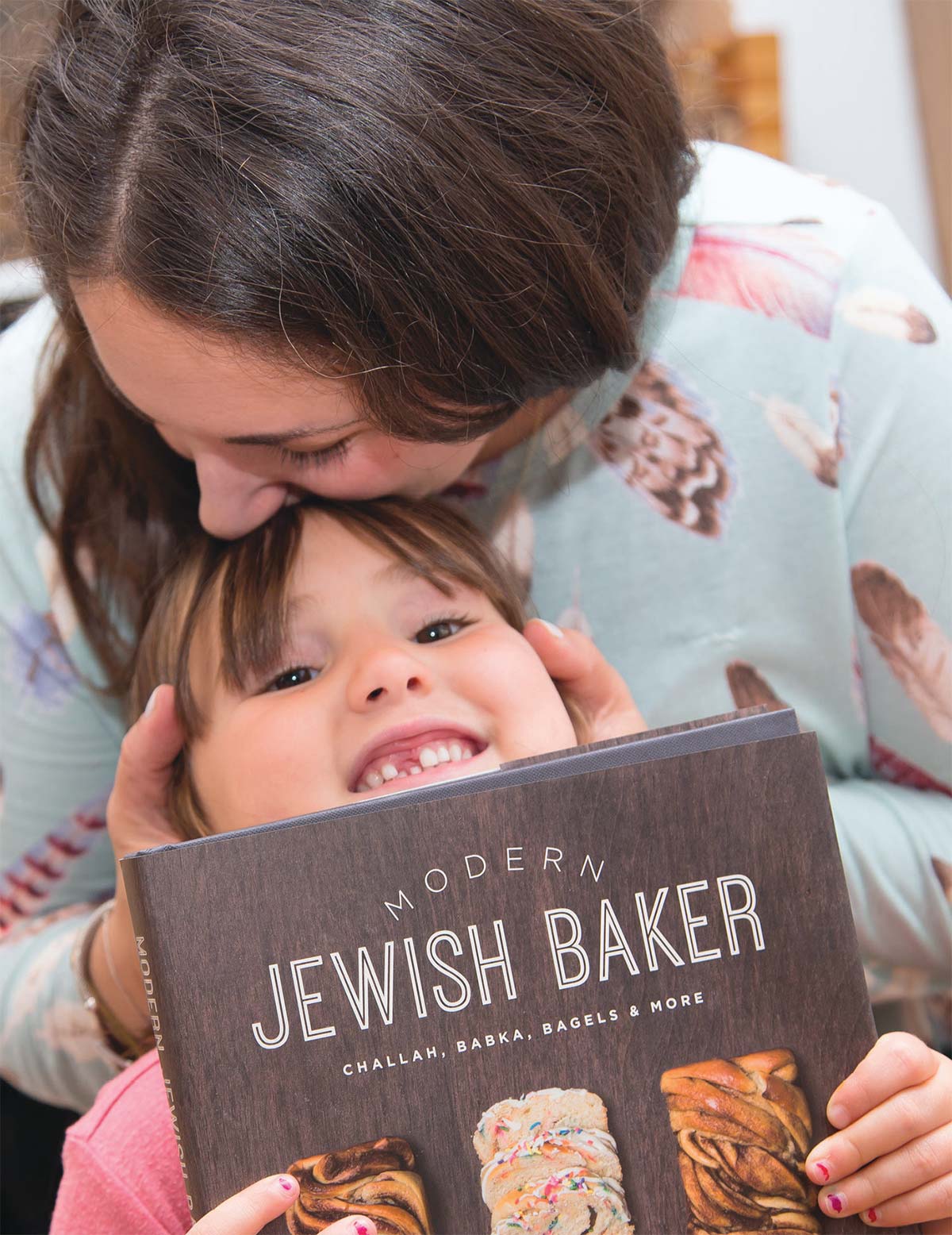
“For every person who says something negative,
there’s a young person who says: ‘Unicorn
challah? I have to make this!’ I care about Jewish
continuity. I just care more about it being
relevant. If a young person is going to make
unicorn challah, they’re still making challah.”
—Shannon Sarna
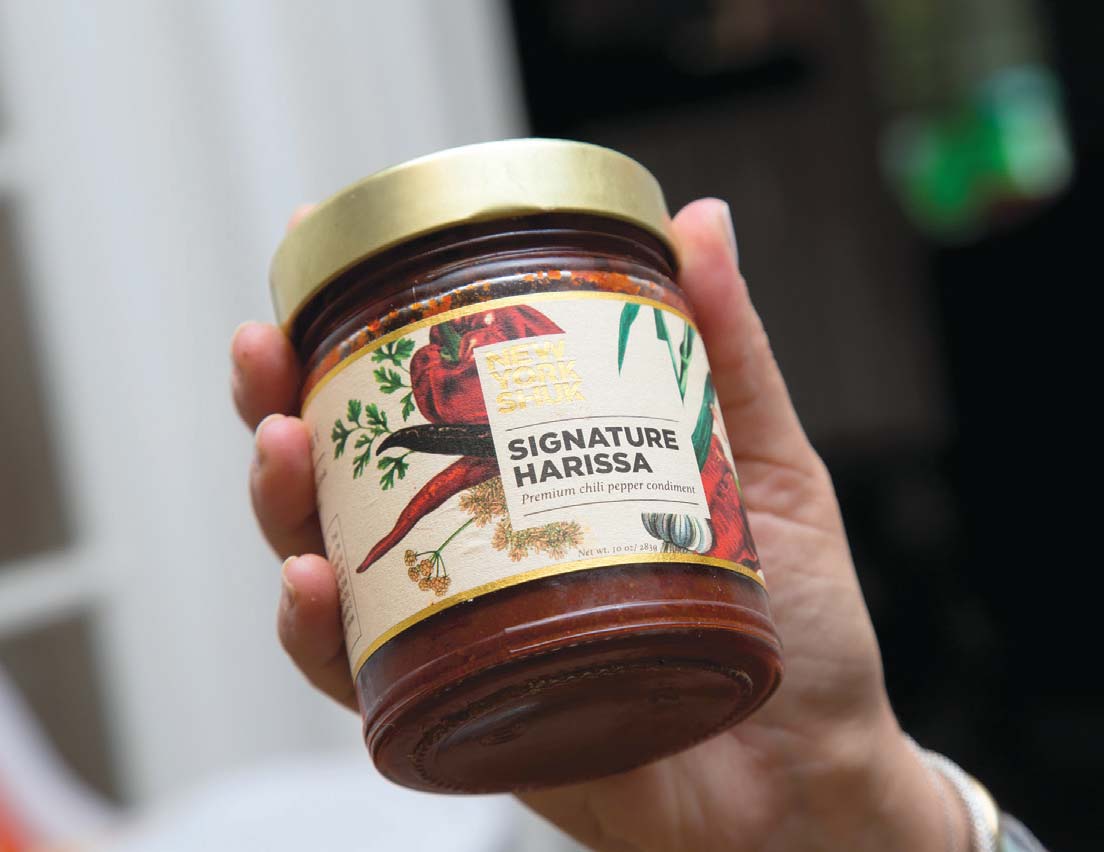
THE BOOK
What was your approach in writing Modern Jewish Baker?
Cookbooks 20 years ago were not the same. They had no pictures. You don’t even know what a dish was supposed to look like. Now, people are consuming food media in a visual way. It changed the landscape. I very much had that in mind. I wanted people to take away a level of confidence in being able to know what the dough was supposed to look and feel like. ‘Now I know how to braid challah, or shape a bagel.’ You’re giving away your secrets, but that’s OK.
You are known as “The Challah Lady.”
It’s the first thing that I baked. After my mom died, I was like: “I’m going to make challah.” The best way that I can describe it is that I don’t have a muscle-memory around what challah should or shouldn’t taste like. Whereas, I can say what a meatball should taste like. I have that muscle memory. But it really wasn’t until I was working on this dinner series called Pop-Up Shabbat, where every dinner would be a different theme. [Founded by Danya Shults, the Friday-night dinner series in Manhattan, since retired, brought together a young crowd, Jewish and otherwise, for food and drinks with a laid-back vibe.] One time I did a butter, brown-sugar, cardamom, golden raisin, pine-nut challah. One time I did a jalapeño, Cheddar, corn challah. Once I started playing with them to that extreme, it was like: ‘What else can I do?’ For a year after, I kept trying different things.
What excites you about pushing boundaries?
For every person who says something negative, there’s a young person who says: ‘Unicorn challah? I have to make this!’ I care about Jewish continuity. I just care more about it being relevant. If a young person is going to make unicorn challah, they’re still making challah.
Any tips for home bakers?
Baking is incredibly scientific, but at the end of the day, and especially when it’s about dough, it’s about the feel. The bagel recipe is definitely the hardest, and will probably take you two times. It’s still going to be delicious no matter what. It’s a fresh bagel. Even the worst homemade challah is delicious, because you’re making your own bread. It’s kind of sacred, and it’s also better for you.
Is there one recipe that is a game-changer?
You can go to Whole Foods and get a good challah. You can’t go to an average supermarket or bakery, even in New York, and find really good, authentic-tasting, Middle Eastern, fluffy pita. Make the pita. It’s a short rise time. It’s very few ingredients. It’s easy, and you don’t need a whole lot of special equipment.
GO-TOs
Any go-to ingredients or cookware?
I have this amazing harissa called New York Shuk. It’s a smokier flavor, not super spicy. I only use King Arthur flour. If you take a bag of generic flour and then King Arthur flour, you can feel it. One other ingredient that I cannot live without is Hershey’s Special Dark cocoa powder. I’m very picky about what kind of chocolate I use: I prefer to use Ghirardelli, or a high-quality 60% or more cocoa chocolate from Whole Foods or Fairway. If you’re melting chocolate for anything, I’ll only use a high-quality chocolate.
I can’t live without Silpats. I have five or six of them.
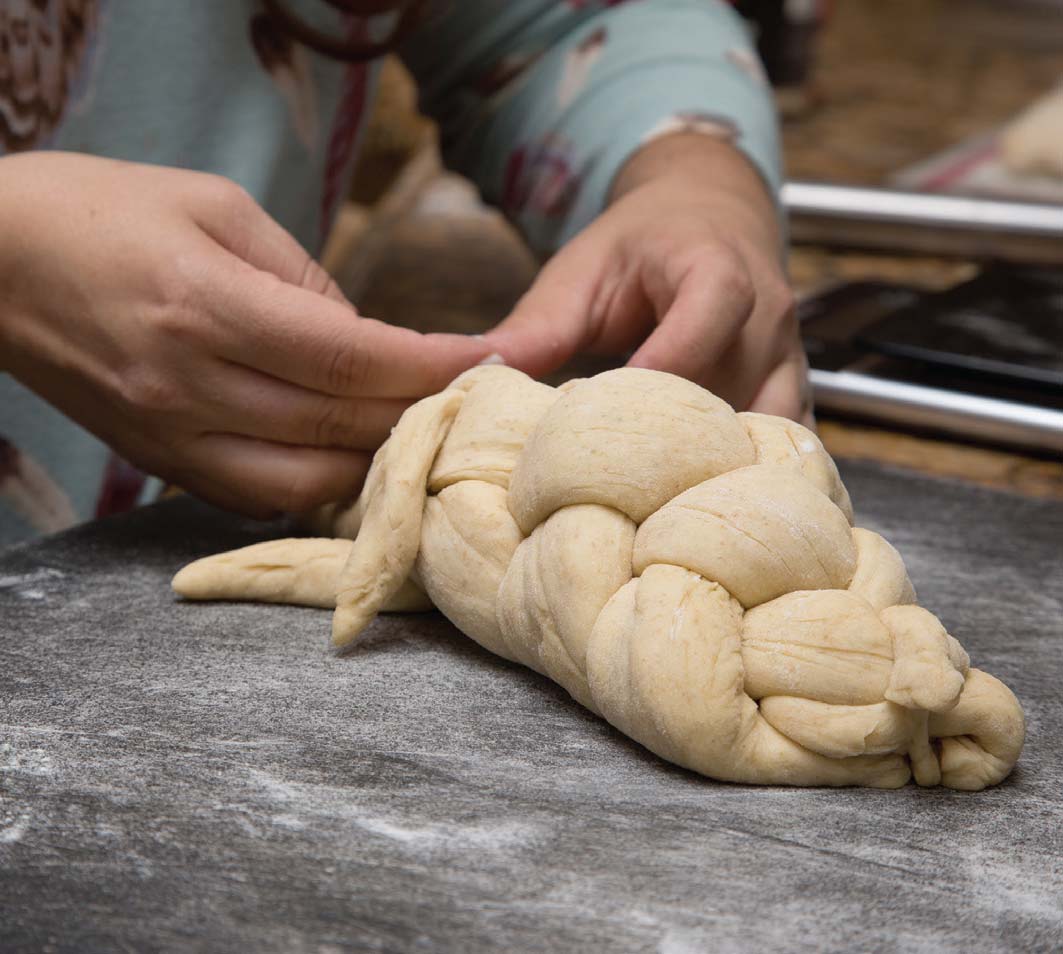
HOLIDAYS AND HOME
Are there certain traditions you return to during the holidays?
I have my grandmother’s honey bowls for Rosh Hashanah, which has the strongest baking tradition. These are my grandmother’s Shabbat candles. And these glasses are from my grandmother’s house. When I would go and stay with her, my favorite thing was to set up a tea party. These are the cups I would use. My sister has some and I have some. We did all of the Jewish holidays at my grandmother’s. Now that she’s getting older, we’ll host a Rosh Hashanah dinner for my family. We always host a Passover Seder. Jonathan and I love cooking and entertaining.
In terms of our Hanukkah traditions, we definitely make latkes. My favorite thing to do with latkes is to serve them almost like they’re blini, with smoked salmon or homemade gravlax, crème fraîche, caviar, fresh dill. I think that’s the best way to have hot potatoes: with those cold, salty accoutrements. We celebrate with both the families, and we do eight nights.
I still love to bake Christmas or holiday cookies. When my mom would have piano recitals, for students, she would have this spread of cookies. There would be all of the Italian white-lace cookies, and green-and-pink leaf cookies and rainbow cookies. What I do now is instead of making overt Christmas cookies, I make a ton of holiday cookies and change it up every year and give them away as gifts. It’s a little bit of connection to my mom, but I make rugelach as part of that—maybe the chocolate-peppermint rugelach, a little Christmas-Jewish thing. It’s a time of year where many intermarried couples struggle with how to balance the holidays.
Your girls, Ella and Billie, will probably be great bakers.
I hope that they are. I see with my older daughter Ella: She’s such a good eater, and she’s so adventurous. She’ll try anything—and she’s a bit sassy about it. Emeril Lagasse had this episode [of Eat the World with Emeril Lagasse] where he went to Shanghai to have real Shanghai soup dumplings. She watched it, and became obsessed.
She would meet someone and say, “Come with me to my favorite restaurant. I’ll teach you how to make soup dumplings.” She loves to bake. She loves to be creative. She looks on Pinterest with me for recipes and [to] plan out birthday cakes. She’ll start planning out Billie’s birthday cake and her birthday cake six months in advance. For me, it’s fun. It’s quality time that we spend together.
[When Ella comes home from school, she adds a bit of detail. “I like apples, watermelon, cucumber and broccoli,” she adds. “Oh, and edamame. It’s like snap peas, but you can only eat the insides.” Tuna is a new discovery with American cheese on “fresh bread.” Adds Sarna, “By fresh bread, she specifically means a baguette.”]
How do you balance being a mom with being a busy food writer and editor?
You have to be a little bit crazy. [Laughs.] I schedule pretty much every hour of the day. I make a list every morning. That was one of the keys for me to be able to write the book.
We have to ask about your rescue pups, Otis and Babka.
Otis was our first rescue. When my husband and I were dating for a year he said he wanted to get a dog, so we adopted Otis together. He needed a lot of special care. We worked with trainers, and we worked really hard to socialize him. Once he acclimates to a situation, he’s great, and he’s amazing with the girls. Billie can sit on top of him and grab his face. He will not do anything. Before I was ready to get pregnant with Billie, I knew it was time to adopt our next dog. We went back to the same shelter. Babka was with us for a full year before Billie was born. We’re absolutely going to get another dog: it’s just a matter of it being the right time.

A COOK’S FAVORITE COOKBOOKS
It’s always interesting to know what cookbooks a good cook most treasures. So, we asked Sarna:
Who doesn’t love Ina [Garten]? She talks about real food and good ingredients, and her recipes are perfect. I want Jeffrey’s favorite… . There’s a shawarma chicken spice blend from Danielle Oran’s Modern Israeli Cooking, which is the only one I’ll use. I love this cookbook, and it’s very much in the vein of this new, Jewish Israeli—style food.
[Sarna pulls out a copy of The Melting Pot, by the Women’s League of the Hebrew Academy of Long Beach.] This was Jonathan’s grandmother’s. This is her handwriting. Community cookbooks are always the best ones. Those are the recipes that people make over and over.
Betty Crocker’s Cooky Book is one I would pour over. This pinwheel recipe was my favorite thing to make with my mom. It was the kind of recipe you had to chill overnight for it to be right. They’re a little harder to make, but those were the ones I always wanted to make. They’re very flaky almost like a palmier. [Sarna picks up another book.] And this was my mom’s copy of Beard on Bread. This is the banana bread recipe that I have made literally my whole life. Now I’ll add wheat flour I’ll add flax seed, zucchini or pumpkin. But this IS the recipe that I made with her, and for my brother when he comes to town. This is the book that really started it for me.


